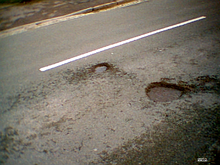- Pothole
-
For other uses, see Pothole (disambiguation).A deep pothole on New York City's Second Avenue

A pothole (sometimes called a kettle and known in parts of the Western United States as a chuckhole) is a type of disruption in the surface of a roadway where a portion of the road material has broken away, leaving a hole.
Contents
Formation
 Small potholes in the road in Banbury, UK
Small potholes in the road in Banbury, UK
Most potholes are formed due to fatigue of the road surface. As fatigue fractures develop they typically interlock in a pattern known as crocodile cracking. The chunks of pavement between fatigue cracks are worked loose and may eventually be picked out of the surface by continued wheel loads, thus forming a pothole.
The formation of potholes is exacerbated by low temperatures, as water expands when it freezes to form ice, and puts greater stress on an already cracked pavement or road. Once a pothole forms, it grows through continued removal of broken chunks of pavement. If a pothole fills with water the growth may be accelerated, as the water "washes away" loose particles of road surface as vehicles pass. In temperate climates, potholes tend to form most often during spring months when the subgrade is weak due to high moisture content. However, potholes are a frequent occurrence anywhere in the world, including in the tropics.
Potholes can grow to feet in width, though they usually only become a few inches deep, at most. If they become large enough, damage to tires and vehicle suspensions occurs. Serious road accidents can occur as a direct result, especially on motorways where vehicle speeds are greater. They are frequently almost invisible to road users.[1]
Repair
Pothole patching is the process of repairing an asphalt based road imperfection. Pothole patching is a year round activity performed by City and County Street Department crews to maintain the area's roads and bridges.
Pothole patching methods are divided into two distinct categories, hot mix and cold mix. Just as the nomenclature suggest, cold mix is a suitable material for the winter months and hot mix is used during the warm spring and summer seasons.
Both hot and cold mix are applied with similar methods. The most widely used method is known simply as throw-and-go. The patching mix is thrown into the pothole along with any debris or water present and compacted with the shovel by manual labor. This method is widely utilized due to the easy application and high rate of production, but the failure rate is extremely high.
The next step in a higher quality application is the throw and roll. In the throw-and-roll method, the patching mix is once again thrown into the pothole manually regardless of any water or debris. Next, a truck slowly drives over the repaired pothole and the mix is compacted. The goal is for the compacted patch to have a crown in the range of 0.125-0.25”. This process will take approximately two more minutes per pothole compared to the throw-and-go method. Although more time consuming, it makes for a more durable patch due to the compaction of the patching mix with the truck tire.
The best-known pothole patching method is the semi-permanent repair. In this method, the pothole is completely removed of any water or debris. Next, the pothole needs to be squared. All uneven edges will be cut with a pavement saw making the hole into a square or rectangular shape. The pothole is cleaned once again before the patching mix is applied. Finally, the area is compacted with a single drum roller or a vibratory plate compacter. The semi-permanent method provides the tightest and longest lasting patch. However, it is more time consuming and requires more workers and equipment in the field.
During the "semi-permanent" repair, a material known as a tack may also be used. Tack is a liquid form material used to promote adhesion of the pothole patch mix, and the pothole surface. If tack is utilized during the repair, it is either sprayed or brushed on the clean and squared pothole. Next, the pothole patching mix is applied and compacted in the desired method, and a final coat of the tack is sprayed on top of the patch overlapping the edges a few inches.
According to the Federal Highway Administration, whichever method is used, patches applied in the winter months typically will not hold up as well as patches applied during the warmer months. The goal for winter patching should be to repair the road as quickly as possible to increase the safety and comfort of the roads. With that stated, the throw-and-go method is favorable as long as a high quality material is utilized. The goal in the warmer months is typically to use the semi-permanent. Utilizing this method while the conditions are ideal will create patches that will last to the extent of the roads life.
See also
- Big Apple Pothole and Sidewalk Protection Committee
- Giant's kettle
References
- ^ Eaton, Robert A.; Joubert, R.H. and Wright, E.A. (December 1989) (in English). Pothole primer—A public administrator's guide to understanding and managing the pothole problem. Special Report. 81-21. U.S. Army Corps of Engineers—Cold Regions Research & Engineering Laboratory. pp. 34. http://www.crrel.usace.army.mil/library/specialreports/SR81-21.pdf.
External links
Categories:- Road construction
Wikimedia Foundation. 2010.

